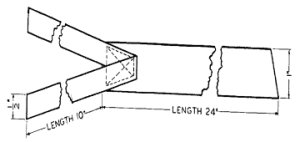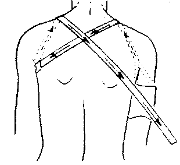5b. Assembly the Figure-8 Harness
Purpose of Figure-8 Harness
- Suspension, through the inverted-y strap
- Excursion, through the control strap
Gather supplies: 1” webbing, 1” four-bar buckles, ½” webbing, ½” flat buckles, Plush (TRS) padding or vinyl tubing and yates clamps.
1) Inverted-Y: Sew two 12-inch pieces of ½-inch webbing to the 1inch webbing as illustrated to the right. Sew this with a box and cross pattern of stitches through the materials. Burn small holes through the lower third of the ½-inch webbing with a thin wire and fasten this through the buckles to the top of the triceps pad or humeral cuff.
|
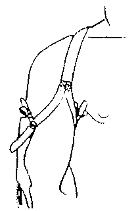
|
| 2) Lay the webbing along the deltopectoral line, up over the shoulder, diagonally across the back, under the opposite axilla, over that shoulder, across the back and the lower third of the ipsilateral scapula. |
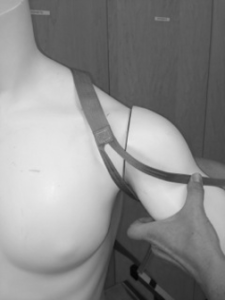
|
| 3) Thread the 1-inch webbing through the hanger and use yates clamps to fasten the control attachment strap and the cross point
The cross point should be located 1 inch below C-7 and 1 inch toward the contralateral side. |
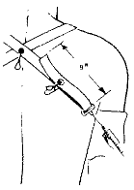 |
| 4) Cut a piece of vinyl tubing or the TRS padding so that it is long enough to extend two inches beyond the front and back edges of the axilla. |
5) Check the harness for comfort and function. Ask the patient to perform some lightweight functions moving the arm and shoulder through various ranges of motion as you assess the position of the straps across the back.
|
6) Completion – remove the harness from the patient.
-
- Sew the crosspoint with box and cross pattern or use the NW ring or BAHA ring
- Sew a 4-bar buckle on control attachment strap (largest space goes toward the ring)
- Add padding (e.g., neo-axilla padding) to axilla region for comfort


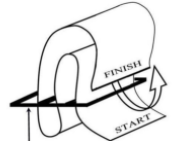
7) Have the patient don the prosthesis and allow him/her to hang arm in a relaxed position. Assess the location of the straps. Ask the patient to perform TD operation in various locations to assess the position of the harness across the back. Adjust the buckles and the harness to assure that there is less than 1 inch of displacement of the socket on the residual limb as the patient lifts heavy objects and that the control strap is comfortable in the patient’s axilla and across the back.
8) The hanger should be positioned so that it is either “always on the back or always off the back”. If the hanger is positioned so that it moves from the air and then onto the patient’s back, the skin may bunch up and be pinched.
- By positioning the hanger always off the back, there is less chance that the hanger will catch or drag across the skin.
- By positioning the hanger always on the back, the patient won’t get pinched as the hanger moves on their skin. However, if the hanger is always on the back, the housing should never contact their skin because the skin may be pulled into the housing as the cable travels in and out of the housing.

